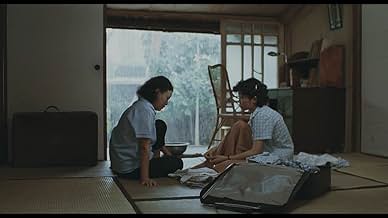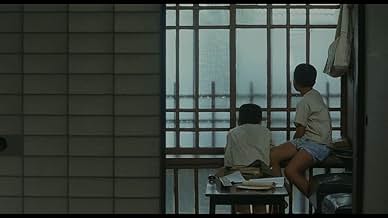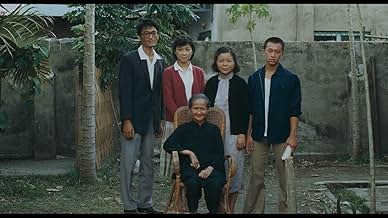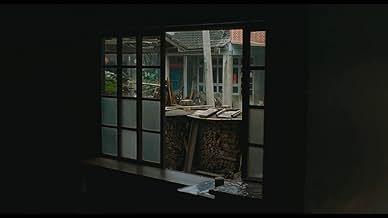IMDb रेटिंग
7.5/10
3.8 हज़ार
आपकी रेटिंग
अपनी भाषा में प्लॉट जोड़ेंThe semi-autobiographical film on director Hou Hsiao-Hsien's childhood and adolescence, when he was growing up in Taiwan, living through the deaths of his father, mother and grandmother.The semi-autobiographical film on director Hou Hsiao-Hsien's childhood and adolescence, when he was growing up in Taiwan, living through the deaths of his father, mother and grandmother.The semi-autobiographical film on director Hou Hsiao-Hsien's childhood and adolescence, when he was growing up in Taiwan, living through the deaths of his father, mother and grandmother.
- पुरस्कार
- 8 जीत और कुल 5 नामांकन
फ़ीचर्ड समीक्षाएं
Very good movie in every aspect: acting, performance, cutting, quality of images, and plot. This is based on the true memories of the life of the director growing up in Taiwan. We follow this evolution in this movie in such realistic and natural images and scenes that we forget we are watching a movie and it looks like if we were watching real life scenes through someone's window. The main plot tells the story of a young boy who is dealing with family and other issues as he grows up during a certain period in Taiwan's history. A fascinating movie. Good foreign arthouse movies are so underrated on imdb and I don't even know why. I guess this site is for popular movies only and top 250 is ridiculous.
For me, this transparent, transcendental film ranks with with the very best of Bresson and Ozu. Meandering, episodic and deceptively detached in tone, A TIME TO LIVE AND A TIME TO DIE is quite probably Hou Hsiao-Hsien's most daring formal experiment, as well as--surprisingly--his most moving film to date.
Seeking a better life, a teacher brings his family from Mei County in the Kwangtung Province of mainland China to Fengshan in the south of Taiwan in 1947. As a result of the Communist takeover on the mainland, the family is forced to remain in Taiwan, estranged from their traditional home and culture. The Time to Live and The Time to Die, a semi-autobiographical film by Taiwanese director Hou Hsiao-Hsien, is a compassionate story of a family's struggle to adapt to living in a new society. Loosely based on the childhood memories of Taiwanese director Hou Hsiao-Hsien who came to Taiwan in 1948, the film chronicles the passing of the older generation and the emergence of the new. The director narrates the film from the point of view of the youngest son, Ah-Hsiao (You Anshun), called Ah-ha by his grandmother (Tang Yu-Yuen).
The Time to Live is shot in a reflective style that allows an intimacy with the material. In the first half, the family learns to adjust to their new environment: the children play outside, the family eats dinner together and engage in small family rituals. Hou is observant of the political and technological changes taking place in the background, noting, for example, the increasing number of cars and motorcycles on the streets, the installation of electricity in their home, the improving medical treatment that the parents receive, and a letter from an aunt revealing the Great Leap Forward in China. What doesn't change, however, is the continued second class status of women, depicted in a scene where the mother lectures the daughters about their responsibilities for housework and how it must come before an education.
As the family gets older, the longing for their homeland increases. On several occasions, the old grandmother becomes disoriented and asks shopkeepers for directions to the Mekong Bridge (in China). When she gets lost, she has to be returned home via taxicab. The second half of the film painfully shows the loss of parental guidance and the disintegration of the family. As illness sets in, the parent's pain and slow disintegration takes place directly in front of the camera, not in the background. Ah Hsiao and his siblings stoically endure the loss of both parents, but their growing involvement in delinquency and petty crime underscores the loss of structure in their lives.
This is Hou's most personal film and one that is filled with images of extraordinary power. I was moved to see Ah Hsiao face when he sees death for the first time while walking into the room containing his father's body, and when the family shares loving recollections of the father soon after his death. Backed by a lyrical soundtrack, the street scenes and images of family life convey a rare authenticity and visual poetry. As in the film "Pather Panchali" by Satyajit Ray, the tiny village in Taiwan becomes a microcosm of the outside world. Like Ray's masterpiece, it is a sad film, yet, in its celebration of the wonder of life and the strength of the human spirit, it is also triumphant. The Time to Live and the Time to Die is not only a loving tribute of one son to his family but a testament to the strength of all families.
The Time to Live is shot in a reflective style that allows an intimacy with the material. In the first half, the family learns to adjust to their new environment: the children play outside, the family eats dinner together and engage in small family rituals. Hou is observant of the political and technological changes taking place in the background, noting, for example, the increasing number of cars and motorcycles on the streets, the installation of electricity in their home, the improving medical treatment that the parents receive, and a letter from an aunt revealing the Great Leap Forward in China. What doesn't change, however, is the continued second class status of women, depicted in a scene where the mother lectures the daughters about their responsibilities for housework and how it must come before an education.
As the family gets older, the longing for their homeland increases. On several occasions, the old grandmother becomes disoriented and asks shopkeepers for directions to the Mekong Bridge (in China). When she gets lost, she has to be returned home via taxicab. The second half of the film painfully shows the loss of parental guidance and the disintegration of the family. As illness sets in, the parent's pain and slow disintegration takes place directly in front of the camera, not in the background. Ah Hsiao and his siblings stoically endure the loss of both parents, but their growing involvement in delinquency and petty crime underscores the loss of structure in their lives.
This is Hou's most personal film and one that is filled with images of extraordinary power. I was moved to see Ah Hsiao face when he sees death for the first time while walking into the room containing his father's body, and when the family shares loving recollections of the father soon after his death. Backed by a lyrical soundtrack, the street scenes and images of family life convey a rare authenticity and visual poetry. As in the film "Pather Panchali" by Satyajit Ray, the tiny village in Taiwan becomes a microcosm of the outside world. Like Ray's masterpiece, it is a sad film, yet, in its celebration of the wonder of life and the strength of the human spirit, it is also triumphant. The Time to Live and the Time to Die is not only a loving tribute of one son to his family but a testament to the strength of all families.
The Taiwanese movie Tong nien wang shi was shown in the U.S. with the title A Time to Live, a Time to Die (1985). The movie was co-written and directed by Hsiao-hsien Hou, and is said to be semi-autobiographical.
The film is a coming of age story of Ah-Ha, whom we meet as a boy of about seven, and whose life we follow until his late teen years. Ah-Ha's family fled China in 1947, and now live in Taiwan. At first, there was still talk about recapturing the mainland, although those discussions faded away as the reality became clear. Still, Ah-Ha's grandmother is convinced that she can walk back to the mainland, and frequently asks people to help her to get there.
If the movie does, indeed, contain autobiographical elements, Hsiao-hsien Hou had a difficult boyhood. His family was poor, and Illness stalked them. As a teenager, Ah-Ha joins a gang that is extraordinarily violent. (The violence takes place off screen, but it is an ever-present plot element in the second half of the film.)
The plot doesn't give us too many heart-rending moments, but it's still very grim. In fact, as I thought back about it, there was only one truly positive scene when—to Ah-Ha's astonishment--his grandmother is able to juggle three guavas. Imagine a movie that is more than two hours long, and has only about 30 seconds of true happiness in it.
It's hard to recommend a movie like this, but, on the positive side, the camera work is brilliant, the acting is excellent, and the film gives us a glimpse of what life was like for a Chinese subculture—people from the mainland who migrated to Taiwan.
We saw this movie at the excellent Dryden Theatre at Eastman House in Rochester, NY as part of a Hsiao-hsien Hou retrospective. It will work well on DVD.
The film is a coming of age story of Ah-Ha, whom we meet as a boy of about seven, and whose life we follow until his late teen years. Ah-Ha's family fled China in 1947, and now live in Taiwan. At first, there was still talk about recapturing the mainland, although those discussions faded away as the reality became clear. Still, Ah-Ha's grandmother is convinced that she can walk back to the mainland, and frequently asks people to help her to get there.
If the movie does, indeed, contain autobiographical elements, Hsiao-hsien Hou had a difficult boyhood. His family was poor, and Illness stalked them. As a teenager, Ah-Ha joins a gang that is extraordinarily violent. (The violence takes place off screen, but it is an ever-present plot element in the second half of the film.)
The plot doesn't give us too many heart-rending moments, but it's still very grim. In fact, as I thought back about it, there was only one truly positive scene when—to Ah-Ha's astonishment--his grandmother is able to juggle three guavas. Imagine a movie that is more than two hours long, and has only about 30 seconds of true happiness in it.
It's hard to recommend a movie like this, but, on the positive side, the camera work is brilliant, the acting is excellent, and the film gives us a glimpse of what life was like for a Chinese subculture—people from the mainland who migrated to Taiwan.
We saw this movie at the excellent Dryden Theatre at Eastman House in Rochester, NY as part of a Hsiao-hsien Hou retrospective. It will work well on DVD.
This film, which first brought Hou and the Taiwanese New Wave to international attention, seems deceptively simple, like your run-of-the mill growing-up-humbly-in-a-third-world-country narrative: a young boy, whose family has been transplanted from China to Taiwan, faces a hard path to adulthood complete with neighborhood tussles and family deaths. But gradually its manner of telling draws you in: at first, events seem like fragmented vignettes, but are actually blended in a succession that has been described as `like watching clouds floating by.' His propensity towards graphically composed, image-driven storytelling recalls the styles of Ozu, Satyajit Ray and even Tarkovsky, but where Hou excels is in applying his style towards an examination on the nature of history. For my money, there has never been a filmmaker as consumed by the idea of history than Hou, and this deeply autobiographical film may shed light on his motivations. By the time we reach the devastating ending, there's an overwhelming feeling of a time and place, an entire way of life, that has slowly disappeared before our eyes, but even more heartbreaking is the profound sense of guilt, of youthful opportunity squandered in hoodlum-like loitering, of parents whose presence was taken for granted until the sudden arrival of their ineffable absence. Watch this film to see how movies are humankind's noble, anxious attempt to retrieve lost time, and how the retrieval only reflects back on the mournful permanence of that loss.
क्या आपको पता है
- ट्रिवियाThis film is inspired by screenwriter-turned-director Hou Hsiao-Hsien's coming-of-age story. It is the second installment of Hou Hsiao-Hsien's "Coming-of-Age Trilogy" that features three prominent Taiwanese screenwriters' coming-of-age stories - the other two are Dong dong de jiàqi (1984) (inspired by the childhood memories of Chu Tien-Wen) and Liàn liàn fengchén (1986) (inspired by the coming-of-age story of Wu Nien-Jen).
- कनेक्शनFeatured in When Cinema Reflects the Times: Hou Hsiao-Hsien and Edward Yang (1993)
टॉप पसंद
रेटिंग देने के लिए साइन-इन करें और वैयक्तिकृत सुझावों के लिए वॉचलिस्ट करें
- How long is A Time to Live and a Time to Die?Alexa द्वारा संचालित
विवरण
- रिलीज़ की तारीख़
- कंट्री ऑफ़ ओरिजिन
- आधिकारिक साइट
- भाषाएं
- इस रूप में भी जाना जाता है
- A Time to Live and a Time to Die
- फ़िल्माने की जगहें
- उत्पादन कंपनियां
- IMDbPro पर और कंपनी क्रेडिट देखें
इस पेज में योगदान दें
किसी बदलाव का सुझाव दें या अनुपलब्ध कॉन्टेंट जोड़ें























